Today, we know a lot more about older adults and their need to exercise. Regardless of their health and physical abilities, older adults can gain a lot by staying physically active. Even if you have difficulty standing or walking, you can still exercise and benefit from it. In fact, in most cases, you have more to lose by not doing anything.
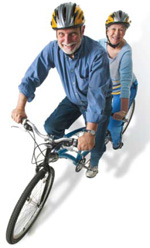 Exercise and physical activity benefit every area of your life. They can:
Exercise and physical activity benefit every area of your life. They can:
- Help maintain and improve your physical strength and fitness.
- Help improve your ability to do the things you want to do.
- Help improve your balance.
- Help manage and prevent diseases like diabetes, heart disease, breast and colon cancer, and osteoporosis.
- Help reduce feelings of depression, may improve mood and overall well-being, and may improve or maintain some aspects of cognitive function, such as your ability to shift quickly between tasks, plan an activity, and ignore irrelevant information.
As you've probably noticed, the key word is you. The benefits you gain from physical activity will depend on your starting point and how much effort you put into it. You'll need to match your physical activity to your own needs and abilities. For example, some people can swim a mile without thinking twice about it. For others, a slow walk to the corner and back is a big achievement. Exercise and physical activity are good for just about everybody, and there are many activities to choose from. This guide has ideas to help you be active and have fun.
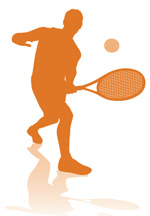 Having fun and socializing are major reasons active people give when asked why they exercise. Ramesh can show you how:
Having fun and socializing are major reasons active people give when asked why they exercise. Ramesh can show you how:
"I started playing tennis 38 years ago for pleasure. After moving south to get away from the cold and snow of the Midwest, I started playing year round. I play with friends every weekend, both singles and doubles. After tennis, we socialize over refreshments. That's the best part of our get-together. At age 65, I'm the oldest in the group; the youngest is 16. I love the game and hope to play forever."
What Kinds of Exercises and Physical Activities Improve Health and Physical Ability?
Exercises generally fall into four main categories: endurance, strength, balance, and flexibility. Though we describe them separately, some activities fit into several categories. For example, many endurance activities also help build strength, and strength exercises can help improve balance.
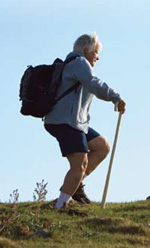 Endurance
Endurance
Endurance, or aerobic, activities increase your breathing and heart rate. These activities help keep you healthy, improve your fitness, and help you do the tasks you need to do every day. Endurance exercises improve the health of your heart, lungs, and circulatory system. They also delay or prevent many diseases that are common in older adults such as diabetes, colon and breast cancers, heart disease, and others. Physical activities that build endurance include:
- Brisk walking
- Yard work (mowing, raking)
- Dancing
- Jogging
- Swimming
- Biking
- Climbing stairs or hills
- Playing tennis
- Playing basketball
Strength
Even small increases in muscle strength can make a big difference in your ability to stay independent and carry out everyday activities such as climbing stairs and carrying groceries. Some people call using weight to improve your muscle strength "strength training" or "resistance training." Strength exercises include:
- Lifting weights
- Using a resistance band
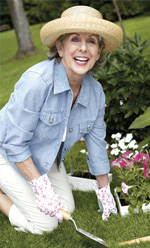 Balance
Balance
Balance exercises help prevent falls, a common problem in older adults. Many lower-body strength exercises also will improve your balance. Exercises to improve your balance include:
- Standing on one foot
- Heel-to-toe walk
- Tai Chi
Flexibility
Stretching can help your body stay flexible and limber, which gives you more freedom of movement for your regular physical activity as well as for your everyday activities. To increase your flexibility, try:
- Shoulder and upper arm stretch
- Calf stretch
- Yoga
|
 |
go here for more info
Chapter 4 shows you how to do the exercises mentioned on this page and many others. |
|
|

When working outdoors, be sure to use sunscreen. Also, wear sunglasses, protective clothing, and a hat with a wide brim.
|
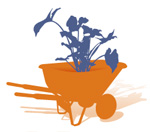 There are many ways to be active. For Pat, age 56, gardening keeps her moving:
There are many ways to be active. For Pat, age 56, gardening keeps her moving:
"I know some people think gardening isn't really exercise, but I'm here to say, "Are they kidding?" Maybe I'm only exercising my imagination when I pore over plant catalogs to pick out seeds for the garden, but when spring comes, all that changes. Working in my garden means bending and lifting, moving and stretching, not to mention digging and hauling! Anyone who's ever had a garden knows that shoveling compost, lifting 40-pound bags of mulch, transplanting seedlings, dividing plants, and pulling weeds are serious physical activities. For avid gardeners, there's always something to do, from spring planting and weeding to fall raking and cleanup. It keeps a body moving!"
|
Exercise and Everyday Activities Go Together
Exercise and physical activity are good for your health. In addition, improving your endurance, strength, balance, and flexibility can help you do many of your everyday activities. For example: |
Endurance activities will make it easier for you to:
- Push your grandchildren on the swings
- Vacuum
- Rake leaves
|
Strength training can maintain your ability to:
- Carry a full laundry basket from the basement to the second floor
- Carry your smaller grandchildren
- Lift bags of mulch in the garden
|
Flexibility, or stretching, exercises make it possible for you to:
- Look over your shoulder to see what's behind you as you back the car out of the driveway
- Make the bed
- Bend over to tie your shoes
| Balance exercises can help you:
- Stand on tiptoe to reach something on the top shelf
- Walk up and down the stairs
- Walk on an uneven sidewalk without falling
|
<<Back | Next >>
